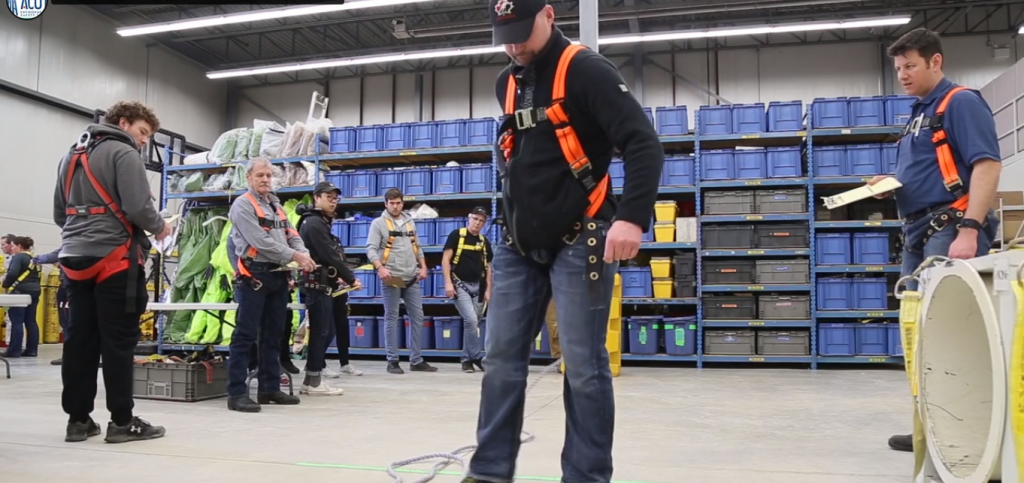If you are planning to conduct a HSE (Health, Safety, and Environment) presentation but y0u need some advice, this article is for you. HSE forms the cornerstone of a resilient and responsible workplace. HSE practices ensure the well-being of employees, protect the environment, and contribute to the overall success of an organization.
This article offers essential tips, relevant for supervisors and members of the health and safety committee, to deliver impactful HSE presentations that resonate with your audience.
Click on each corresponding link to jump ahead:
- Know Your Audience and Tailor Your Message
- Use Clear and Concise Communication
- Encourage Audience Interaction
- Utilize Multimedia and Real-World Examples
ACUTE Environmental is your go-to resource for all things safety training. Simply contact us today to set up your safety training!
Tips For Conducting HSE Presentations

Continue reading to learn how to give a great HSE presentation.
1. Know Your Audience and Tailor Your Message
The first thing you need to do before you conduct your HSE presentation is take some time to understand your audience.
Supervisors and committee members should be aware of the specific concerns and interests of their team. Tailor your message to address the unique challenges and priorities of your audience, making the information more relevant and engaging. If you do this:
- Your message will appear more relevant
- Engagement will increase
- Buy-in and commitment will increase
Now, you may asking “how exactly do I get to know my audience and effectively tailor my message to them? Here are some tips to help you with this:
A) Conduct Audience Analysis
Before your presentation, gather information about your audience. This could include their:
- Roles
- Responsibilities
- Past safety concerns
- Any specific challenges related to their work
This information helps you tailor your message to resonate with their experiences.
B) Customize Examples

When welding, always wear the proper PPE to prevent arc eye and other injuries.
Use examples that directly relate to the audience’s work environment. If possible, incorporate incidents or success stories from within the organization to make the content more relatable and credible.
For example, perhaps you are presenting to a group of welders. Share a recent story of someone who experienced arc eye and how to avoid it.
C) Address Specific Concerns
During your presentation, explicitly address the concerns and priorities that are particularly relevant to your audience. This demonstrates a proactive approach and shows that the organization is attentive to the unique challenges faced by its employees.
For example, perhaps you are conducting a HSE presentation to a group of roofers. One of their main concerns is their overall safety and risk of falls given that they are working at heights. Therefore, presenting on safety tactics to prevent slips, trips, and falls is a great idea.
Knowing your audience and tailoring your message is about recognizing that a one-size-fits-all approach doesn’t work in HSE presentations. By customizing your content to align with the unique characteristics and concerns of your audience, you create a more engaging and impactful presentation that resonates with your team’s specific needs.
2. Use Clear and Concise Communication

Clear and concise communication will increase the satisfaction of those listening to your HSE presentation.
When delivering an HSE presentation, like any presentation, clarity is paramount!
Ensure that your message is easily understandable to a diverse audience. Utilize visual aids to reinforce your key points and connect with visual learners, such as:
- Charts
- Graphs
- This will make complex information more accessible
Not only does being clear and concise in the way you communicate improve accessibility but it will also increase overall retention and reduce misinterpretations.
To ensure that you speak clear and concise, consider the following tips:
A) Speak Slowly and Clearly
Enunciate your words, and maintain a moderate pace when speaking. Speaking too quickly can make it difficult for the audience to follow, especially if English is not their first language or if the topic is technical. Take deliberate pauses to allow the audience to absorb information.
B) Avoid Technical Jargon

Avoid technical jargon! Instead of saying “SDS” say “Safety Data Sheet”.
While technical terms may be familiar to experts in the field, it’s important to remember that your audience may have varying levels of familiarity with HSE terminology. Minimize the use of technical jargon and, when it’s necessary, provide clear explanations or definitions to ensure understanding. For example:
- Instead of saying “PPE” say “personal protective equipment”
- Instead of “ergonomics” say “designing the job to fit the worker”
- Instead of “OSHA compliance,” say “following safety regulations”
These are just some examples of how to avoid using technical jargon.
C) Simplify Complex Information
Break down complex information into digestible segments. Use analogies or metaphors to relate unfamiliar concepts to more familiar experiences. This simplification aids in comprehension and prevents information overload.
Clear and concise communication is foundational in HSE presentations. By speaking clearly, avoiding unnecessary technical language, and leveraging visual aids, you enhance the accessibility of your message, making it more understandable and memorable for a diverse audience.
3. Encourage Audience Interaction

Allow the audience of your HSE presentation to actually engage in hands on work!
Engage your audience by encouraging interaction. This not only keeps participants actively involved but also provides an opportunity for them to share their experiences and perspectives. Fostering a two-way communication channel enhances the effectiveness of your presentation.
Here are some tips to encourage audience interaction during your HSE presentation:
A) Pose Thoughtful Questions
Begin your presentation by posing thought-provoking questions related to the HSE topic. This immediately engages the audience’s thought processes and sets the tone for active participation. For example, you can ask:
- “Do you know the environmental footprint of your daily activities, and what steps can we collectively take to reduce our impact?”
- “How often do you prioritize your mental health and well-being in a world that constantly demands our attention?”
- “What does a strong safety culture mean to you, and how do you think it influences the overall success of an organization?”
These are all great questions you can ask to engage with your audience.
B) Utilize Polls and Surveys
Integrate technology by using polls or surveys to gather instant feedback from the audience. This not only breaks up the monotony of a one-way presentation but also provides valuable insights into the audience’s understanding and opinions on specific topics.

Polls and surveys are an excellent way to gather feedback from your audience.
C) Incorporate Interactive Activities
Design interactive activities or simulations that mirror real-world HSE scenarios. These activities not only reinforce key concepts but also provide a hands-on, engaging experience for participants.
Consider the following interactive activity:
Objective
The goal of this activity is to engage participants in a hands-on exploration of real-world safety scenarios, encouraging them to apply HSE principles and problem-solving skills.
Materials Needed
- Scenario Cards: Prepare a set of scenario cards, each describing a specific workplace safety situation. Ensure a mix of common and industry-specific scenarios.
- Flip Chart or Whiteboard: For recording participant responses and facilitating group discussions.
- Markers and Sticky Notes: To allow participants to write down their solutions and insights.
Instructions
Introduction (10 minutes)
- Briefly introduce the activity and its objectives.
- Emphasize the importance of applying HSE principles in real-world situations.
Distribution of Scenario Cards (5 minutes)
- Distribute scenario cards to small groups or individuals.
- Instruct participants to read and discuss the scenario within their group.
Group Discussion (15 minutes)
- Encourage groups to analyze the scenario, identifying potential hazards and risks.
- Prompt participants to discuss how they would address the situation based on HSE principles.
- Each group should prepare a brief summary of their analysis and proposed solutions.
Presentation of Solutions (10 minutes)
- Invite each group to share their analysis and proposed solutions with the larger audience.
- Record key points on the flip chart or whiteboard.
Open Floor Discussion (10 minutes)
- Facilitate an open discussion by encouraging participants to ask questions and provide additional insights.
- Explore alternative solutions and discuss the potential consequences of different approaches.
Reflection and Key Takeaways (5 minutes)
- Conclude the activity by summarizing key takeaways from the scenario discussions.
- Emphasize the importance of critical thinking and proactive problem-solving in maintaining a safe workplace.
This is just one example of how easy it is to incorporate interactive activities into your HSE presentation.
4. Utilize Multimedia and Real-World Examples

Incorporating real-world examples in your HSE presentation will increase engagement.
Incorporate multimedia elements to enhance the visual appeal of your presentation. Videos, photos, and real-world examples can vividly illustrate key concepts and drive home the importance of HSE practices.
Share relevant YouTube videos that showcase best practices or highlight case studies, offering a dynamic and engaging learning experience. Here are some tips for implementing multimedia and real-world examples:
A) Incorporate videos
Share professionally produced videos and case studies that demonstrate HSE best practices in various workplace settings. These videos can showcase:
- Correct safety procedures
- The proper use of equipment
- Successful implementations of safety protocols
Check out our article “5 Great Safety Videos for Your Warehouse” for a list of YouTube videos you can incorporate into your HSE presentation.
B) Use Before and After Photos
Before HSE:

After HSE:

Before and after photos are great for education workers during your HSE presentation.
Present visual comparisons, using photos or graphics, to depict situations before and after the implementation of safety measures. This can illustrate the tangible impact of HSE practices.
For example, in the image above, we see how far we have come in terms of safety in the workplace! Especially when it comes to working at heights.
C) Show Real-World Examples
Tailor your examples to the specific industry or workplace of your audience. For instance, if you’re addressing a manufacturing team, show examples relevant to manufacturing safety.
You can also discuss real-world incidents (without compromising confidentiality) and analyze them critically, highlighting the importance of preventive measures.
The strategic use of multimedia and real-world examples elevates the impact of your HSE presentation by making it visually engaging, emotionally resonant, and directly applicable to the audience’s experiences. Combining varied media formats ensures a dynamic and memorable learning experience for your audience.
Trust ACUTE Environmental For HSE Training

ACUTE can transform your workplace to be more safety compliant.
If you are in charge of supervising health and safety in the workplace or you are concerned that your workplace is not safety complaint, book a course with ACUTE. Here are some of the benefits of working with ACUTE:
- Open Door Instructor-Student Partnership – ACUTE’s training services emphasize client participation, staff foster relationships with clients and serve as a touchstone for advice anytime moving forward.
- Serving Your Team and Industry – With a vast array of clients in manufacturing, construction, health, academic, and government sectors, ACUTE brings the best safety practices from across the spectrum to your workplace.
- 100 Years Combined Experience – ACUTE provides comprehensive health and safety training, on-site safety services, and consulting services. With over 100 years of combined experience, our company staff offers more than theoretical or abstract ideas. ACUTE offers solutions!
- Track Record of Success – ACUTE is rated 4.9/5 stars on Google reviews, demonstrating our commitment to our clients, our quality, and our passion for training.
It is one thing to understand what HSE is and another to know how to conduct a HSE presentation. Contact Acute Environmental today to learn more about health, safety, and the environment.
What Our Customers Are Saying…
We were referred to ACUTE on behalf of our employer for an n95 mask fitting – the staff here are professional, personable, and informative.
I’d come back here for any safety-related training in a heartbeat.
Acute has been a staple in supporting my companies over the years and have always delivered quality and dependable service. Training programs are top shelf and a great facility for practical application. couldn’t recommend them more. keep up the great work folks.
Outstanding service provided by Acute, right from the customer support end, right through to the delivery of the session. Always professional, quick to respond, and always delivering services that exceed my expectations. Acute has an amazing team that is always helping us achieve better health and safety performance. So are grateful to have such a tremendous resource in Acute!
Hours of Operation and Contact Information:
Monday-Friday: 8:00 AM – 5:00 PM
Saturday-Sunday: Closed
Phone: (519) 747-5075
Fax: (519) 747-4608
Email: info@acuteservices.com

